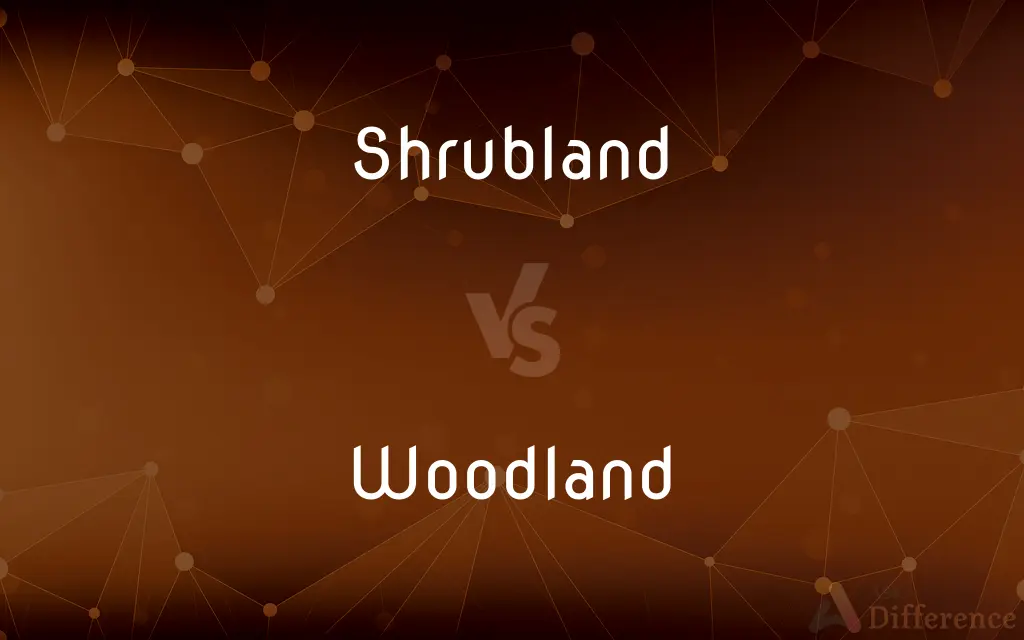Shrubland vs. Woodland — What's the Difference?
By Fiza Rafique & Maham Liaqat — Updated on April 26, 2024
Shrubland is dominated by low-lying woody plants and bushes, offering a sparse canopy, while woodland features a mix of mature trees with a more substantial canopy, providing denser shade.

Difference Between Shrubland and Woodland
Table of Contents
ADVERTISEMENT
Key Differences
Shrubland consists primarily of shrubs and bushes, adapted to environments that can range from dry to moist, but often where extreme conditions such as drought or poor soil limit larger plant growth. In contrast, woodland areas are characterized by a higher density of trees that form a semi-open canopy, which influences the undergrowth and wildlife diversity beneath it.
The vegetation structure in shrublands is generally lower to the ground, often not exceeding a few meters in height, making these areas less dense and more open to sunlight. Whereas woodlands feature a tiered vegetation structure that includes not only mature trees but also younger trees and various forms of underbrush, creating layers of habitat.
Shrublands are typically found in regions that experience significant environmental stress, such as chaparral in California, which is adapted to periodic wildfires and dry summers. On the other hand, woodlands are often located in more temperate climates where there is sufficient moisture to support taller tree growth without reaching the density of forests.
The ecological dynamics of shrubland involve adaptations to survive in harsher, often nutrient-poor soils and with less available water. This contrasts with woodland ecosystems, which usually support a richer biodiversity due to more favorable living conditions provided by the tree canopy, such as moderated temperatures and soil moisture conservation.
While shrubland may recover or adapt quickly following environmental disturbances like fire due to the hardiness of shrub species, woodland recovery can be slower because trees take longer to mature. This makes woodlands more susceptible to long-term damage from deforestation and other disturbances.
ADVERTISEMENT
Comparison Chart
Primary Vegetation
Shrubs and low bushes
Trees with a significant canopy
Height of Vegetation
Generally under 2 meters
Can exceed 10 meters with mature trees
Environment
Often dry or nutrient-poor
Typically more temperate and moist
Biodiversity
Lower due to harsh conditions
Higher due to more layers and resources
Recovery from Disturbances
Often faster due to plant resilience
Slower due to longer tree maturation
Compare with Definitions
Shrubland
Land area dominated by shrubs.
The shrubland was thick with brushwood and small plants.
Woodland
Habitat with significant tree canopy.
Woodland areas are crucial for sustaining diverse wildlife populations.
Shrubland
Common in coastal and mountainous regions.
Coastal shrubland experiences strong winds that limit tree growth.
Woodland
Features a mix of tree sizes.
The woodland was a mix of young saplings and towering oaks.
Shrubland
Characterized by low-lying vegetation.
The low growth of shrubland makes it distinct from forested areas.
Woodland
Area covered with dense growth of trees.
The woodland provided a cool, shaded area during the hot summer.
Shrubland
Prone to environmental disturbances.
Shrubland often recovers quickly from wildfires due to resilient plant types.
Woodland
Typically found in temperate zones.
Temperate woodlands are lush with both deciduous and evergreen trees.
Shrubland
Ecosystem adapted to arid conditions.
Shrublands flourish in areas where other vegetation might struggle.
Woodland
Supports a variety of ecological interactions.
The ecological balance in the woodland includes birds, mammals, and insects.
Shrubland
Shrubland, scrubland, scrub, brush, or bush is a plant community characterized by vegetation dominated by shrubs, often also including grasses, herbs, and geophytes. Shrubland may either occur naturally or be the result of human activity.
Woodland
A woodland ( (listen)) is, in the broad sense, land covered with trees, or in a narrow sense, synonymous with wood (or in the U.S., the plurale tantum woods), a low-density forest forming open habitats with plenty of sunlight and limited shade (see differences between British, American, and Australian English explained below). Woodlands may support an understory of shrubs and herbaceous plants including grasses.
Shrubland
An area, such as chaparral, covered chiefly with shrubs and small trees.
Woodland
Of or relating to a Native American culture prevalent throughout much of eastern North America beginning around 1000 BC and lasting especially in northeastern regions until contact with Europeans, characterized by increasing reliance on settled agriculture, by the development of Neolithic crafts and tools, and in certain areas by the building of ceremonial mounds.
Shrubland
(mostly plural) Land that is covered mostly with shrubs.
Woodland
Of, relating to, or constituting woodland.
Woodland
Living, growing, or present in woodland
Woodland flowers.
Woodland
Land covered with trees.
Woodland
Of a creature or object: growing, living, or existing in a woodland.
The woodland creatures ran from the fire.
Woodland
(obsolete) Having the character of a woodland.
Woodland
Land covered with woody vegetation.
Woodland
Land covered with wood or trees; forest; land on which trees are allowed to grow, either for fuel or timber.
Here hills and vales, the woodland and the plain,Here earth and water seem to strive again.
Woodlands and cultivated fields are harmoniously blended.
Woodland
Of or pertaining to woods or woodland; living in the forest; sylvan.
She had a rustic, woodland air.
Like summer breeze by woodland stream.
Woodland
Land that is covered with trees and shrubs
Common Curiosities
What type of wildlife is typical in shrubland?
Shrubland typically hosts species adapted to open, less shaded environments, such as small mammals, birds, and reptiles.
What primarily distinguishes shrubland from woodland?
The main distinction is the dominant vegetation; shrubland is dominated by shrubs, while woodland is characterized by a higher density of trees.
Are woodlands more biodiverse than shrublands?
Generally, woodlands support greater biodiversity due to the complex habitat structure provided by tree layers and more stable environmental conditions.
Can shrubland evolve into woodland?
Yes, under suitable environmental conditions, shrubland can transition into woodland as trees start to grow and the canopy develops.
What conservation efforts are important for woodland?
Conservation in woodland areas often focuses on protecting mature trees, managing invasive species, and sustaining biodiversity.
How do humans impact shrubland and woodland?
Human activities like agriculture, urban development, and logging significantly impact both ecosystems, often reducing their size and health.
How does the canopy of woodland affect its environment?
The canopy in woodland areas moderates temperature, retains soil moisture, and provides habitat, impacting the entire ecosystem.
What makes woodland a critical ecosystem?
Woodlands are critical for carbon storage, water cycle regulation, and providing resources for wildlife and humans alike.
Are shrublands ever artificially created?
Yes, shrublands can be artificially established or restored as part of ecological management or landscaping projects.
Is fire a common disturbance in shrubland?
Yes, fire is a common and natural part of many shrubland ecosystems, helping to regenerate certain plant species.
How does shrubland adapt to poor soil conditions?
Shrubland plants often have deep or specialized root systems to maximize nutrient uptake in poor soils.
What are the typical climate conditions for shrubland?
Shrubland often thrives in climates with less rainfall and more extreme temperatures, either hot or cold.
What role do trees play in woodland ecosystems?
Trees in woodland ecosystems play a crucial role in creating habitat, providing food, and maintaining the microclimate.
How do shrubland and woodland differ in their approach to water usage?
Shrubland vegetation typically has adaptations like waxy leaves to conserve water, whereas woodland trees may utilize larger amounts of water but help to maintain overall ecosystem moisture levels.
Can woodland areas be used for recreation?
Woodland areas are popular for recreation, providing opportunities for hiking, birdwatching, and enjoying natural beauty.
Share Your Discovery

Previous Comparison
Accountant vs. Bursar
Next Comparison
Protestant vs. PuritanAuthor Spotlight
Written by
Fiza RafiqueFiza Rafique is a skilled content writer at AskDifference.com, where she meticulously refines and enhances written pieces. Drawing from her vast editorial expertise, Fiza ensures clarity, accuracy, and precision in every article. Passionate about language, she continually seeks to elevate the quality of content for readers worldwide.
Co-written by
Maham Liaqat















































